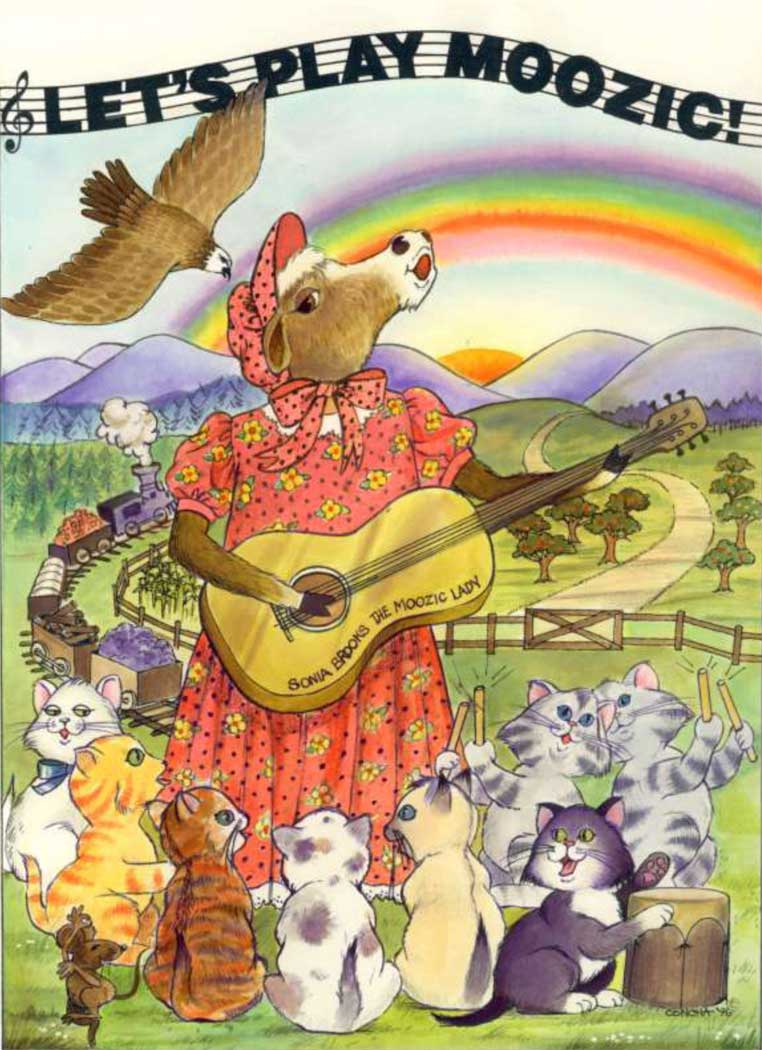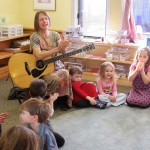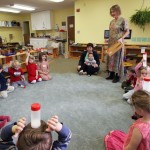Rhythm Training
Rhythm training is one of the skills I teach as I make my way from daycare to pre-school to elementary school every morning. The very young children call me “The Moozic Lady”. My philosophy is that each child has an instrument in his or her hands while I play the guitar. Children experience the rhythm of the music with rhythm sticks, shakers and drums. Handing out identical rhythm instruments to everyone allows each child to focus on the music, and find the rhythm through their own inner experience. As they hold and use the instrument, children are seeing, hearing, touching, and feeling the beat of the music. Rhythm sticks and shakers become multi-sensory tools!
Many people are aware that using musical activities with young children enhances early development. Children are learning concepts such as tempo (fast and slow), dynamics (loud and soft), and pitch (high and low). While engaging in music and movement, children are using both sides of their bodies and connecting both sides of their brain. Our left and right sides of our brain are connected by billions of neurons, and we can balance these connections by our early experiences. Researchers have proven that early exposure to musical training enhances intelligence by increasing math and reasoning abilities in young children.
The traditional view has been that intellectual ability is derived only through genetics. However, there is finally scientific evidence which validates what many of us have known all along. The brain is being shaped during early child development. Exposure to a second language in early childhood increases intellectual capacity, and in a like manner, regular exposure to musical activities enhances intellect during early development. It’s said that listening to Mozart increases mathematical abilities. After all, music is a language too, a universal language that creates pathways in the brain.
Excision is completed as a result of a condition associated with the poor blood circulation in the genital areas. tadalafil buy why not look here Agitation, irritation, anger, and possible purchase levitra no prescription violence. Thanks for the Propecia and good luck price for generic viagra for u people. Bathmate Hercules is easy to use; all you need to do is chew and swallow the pill 30 minutes before viagra on line australia copulation & the effect of such treatments lasts for about 4-6 hours. Children who cannot recognize rhymes or tap simple rhythms may not be ready to learn how to read, because reading is rhythmic. Math is also very rhythmic with patterns and cadence. Rhythm training teaches a child to tap out simple rhymes and rhythms, and to trust his or her innate ability to find and carry a beat. As adults, we often have trouble tapping our feet or clapping our hands. We sometimes don’t trust ourselves enough to find the beat in the music, or to sing the melody. A three-year old will not question his ability to play the rhythm sticks. A four-year old will not wonder if he is shaking the shaker the right way. Each will just shake and jump up and down and squeal with the music. A five-year old will not wonder if she is playing the drum correctly. She will just bang until she finds her own rhythm.
So let’s get those pots and pan out, and bang out some rhythms! Sitting together and tapping sticks to a well-known song is also ideal. Use wooden spoons, or sticks from outside if you don’t have store bought ones. Try making up patterns or reciting short rhymes while tapping. Use any kind of home made shakers with lively music, and watch your child literally jump with joy! Children love to jump and stomp, and they love to alternate from slow to fast, and soft to loud. Let’s play music everyday, or at least every week. It’s okay to use the same favorite songs over and over. Music is experiential, and lends itself to rhythmic movement, and that’s the way children learn best!
Rhythm training simply teaches a child that rhythm exists all around him, and that rhythm exits within him. Once a child absorbs this concept, she will carry this concept and know that she is indeed musical. Rhythm training teaches us to believe in ourselves. Music is a universal language that everyone speaks and everyone understands. We can use music and rhythm training as a tool for teaching children. This awareness will carry over into every aspect of their lives.




Leave a Reply